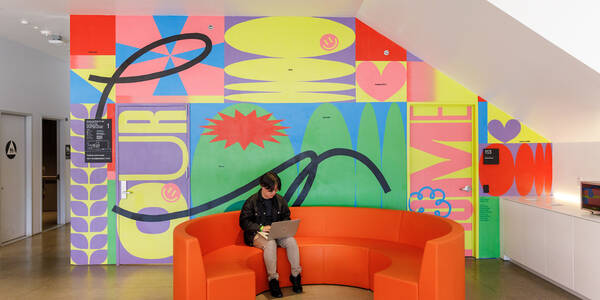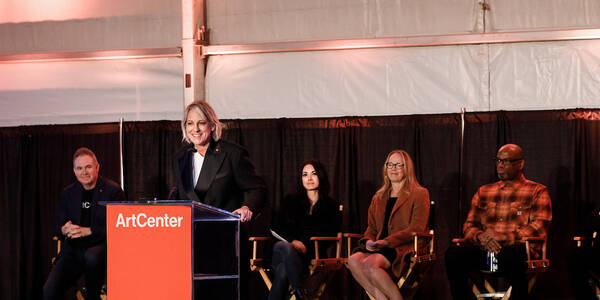feature / alumni / diversity / influencing-change
December 14, 2022
Subscribe to the Newsletter
Sign up to receive the DEI newsletter in your inbox
Influencing Change: DEI at ArtCenter – December 2022
The Gifts of 2022
As 2022 comes to a close, I feel it’s an ideal moment to look at the origin of one of the College's most iconic places of inspiration.
Thirty-three years ago this month, Keith Haring completed his mural on Hillside Campus. The vibrant piece, which Haring invited the community to watch him create, serves as a permanent memorial to artists who have died of AIDS, as well as a symbol of hope and compassion.
Painted over two days (November 29–30, 1989) as part of the second annual AIDS Awareness Day (now, World AIDS Day) and the first-ever Day Without Art, many students watched as he performed his controlled outline and strokes, determined to paint while he still could.
Haring died of AIDS-related complications in February 1990, just two months after the public work was completed. As the Broad Museum mounts a major survey of his work, those of us at ArtCenter have the benefit of viewing his art every day.
Over the years, the mural has become a source of creativity for many of us, and a testament to ArtCenter's commitment to public art and social justice.
This year, the College installed another mural: Students Josse Slater and Evelyn Luu created a colorful piece, this time at South Campus. The mural served as a means to heal following the pandemic and as a tribute to our creative resilience. In the words of the artists, the mural is a way to remind students about "why we came to ArtCenter in the first place—to pursue and do what we love.”
In three decades time, I wonder how students will view this piece. And how the world will make meaning of the events we've gone through over these past two years. While there’s still much to overcome, one thing is for sure, I'm optimistic of what's to come.

While there’s still much to overcome, one thing is for sure, I'm optimistic of what's to come.
Aaron I. Bruce, MIBA, Ph.D., Chief Diversity Officer
Access for All
Speaking of art from the past, Saturday, December 3, marked International Day of Persons with Disabilities. As part of an IMLS grant-funded project, Reimagining Access: Inclusive Technology Design for Archives and Special Collections, students have harnessed the principles of Universal Design to make ArtCenter's archives more accessible.
This project—which included a symposium, two studio classes and further prototype development—was created in collaboration with our Library, Interaction Design and Designmatters departments, and yielded exciting student outcomes that represent an important step in making our campus more inclusive and making inclusivity fundamental to how we teach design.
This project was made possible in part by the Institute of Museum and Library Services.
Spotlight: Melinda Paix Arredondo, Identificar(x) Curator
As we plan Identificar(x), an exhibition spotlighting ArtCenter's Latin-identified alumni community, I'm using this space to introduce the project’s artists and curatorial team. Melinda Paix Arredondo (BFA 20 Photography) is a fine art, portrait and fashion photographer, whose boundary-pushing work pokes at the constructs of beauty, religion and culture. The recent grad also teaches young womxn and gender expansive youth at Las Fotos Project, a nonprofit photography mentoring program. I look forward to seeing what this incredible artist brings to the project.
My Lived Experience: Pulling Back the Veil
As part of my commitment to share the contributions of our community, I'll be selecting creators whose identities inform their work. A master in the diversity of sound, Estevan Carlos Benson, part of ArtCenter's Graphic Design faculty, shares how his identity and work are intertwined:
"As a person of mixed identity from a homogeneous part of Texas, I sought to understand myself through my work. In my early days as a student at major universities, my creative practice would sometimes hit a cultural brick wall; professors of my past couldn't connect with my research of African drums or Haitian art.
I've learned to hold my values more strongly, and I express them through a philosophy that values intention, uncertainty and spirituality. My recent work of sound design and composition for the short film, Blue Veil, is part of that.
The film, directed by Shireen Alihaji, takes place in the wake of 9/11 and tells the story of a first-gen Muslim teenager as she discovers her mother's record collection. The film plays with time and memories while sounds of warm tones and distant voices create connective tissues between moments. My contributions enhance the narrative's sense of ambiguity. Interestingly, the story also confronts matters of identity and lived experiences."
A Picture's Worth
I've been eager to share the incredible work from the new course What's Your Story. By taking professional portraits at cultural events, the Photography and Imaging Department hopes to create a portrait of the people of Los Angeles across a breadth of communities. Students first set up the photo booth at Leimert Park's Juneteenth celebration, and next term, the plan is to capture L.A. Pride. In addition to the power of subjects receiving a professional portrait, instructor Ken Marchionno says, the course offers our students "a deeper connection to the community by sharing their expertise with the world." The class, co-taught by Manjari Sharma, is open to all majors.
Participating photographers included Sophia Liv Maguire, Erick M. Mendoza-Ojeda, Nori Rasmussen-Martinez, Aric Van Halen and Amanda Rae Villegas, with professors Ken Marchionno and Everard Williams.
.
Honoring Those Who Have Served
Members of the veteran employee resource group, including Rollin Homer, Greg Stevens and Greg Olson, recently hosted a veteran's lunch for staff, faculty and students on November 10, the birthday of the Marine Corps. Vets from a variety of military branches joined us to connect and share stories of their service. Given the many contributions that veterans bring to campus life, scholarship support is essential: In addition to institutional grants and scholarships, ArtCenter provides support to our veteran students through anonymous donations and via the Ahmanson Veterans Scholarship Initiative.
Winter Celebrations
As students prepare for final presentations and ArtCenter looks forward to a winter break, it’s worth noting the many holidays individuals celebrate at this time of year, including Christmas, Hannukah, Kwanzaa, Diwali, Eid-al-Adha and Las Posadas, and many others. We wish all of you a very warm holiday season and a happy new year.
The Last Word
Early this month, we hosted our final Dialogues in Diversity & Design of the year, featuring Cristopher Gonzalez, a designer at Apple. I'll be sure to share a recap with you soon. In the meantime, you can catch up on our conversations with Nike footwear designer Erick Ikeda (BS 15 Product Design) and Marvel Studios background artist Jacki Li (BFA 20 Illustration).
As always, I’m thankful to share this space with you. And if you know anyone who'd also enjoy our conversation, please ask them to subscribe.
Wishing you and yours infinite possibilities in 2023.
Aaron I. Bruce, MIBA, Ph.D.
Vice President, Chief Diversity Officer
ArtCenter College of Design
Related

feature
'Healing our inner child': Students unveil a bright, bold mural at ArtCenter's South Campus
July 06, 2022

feature
October 2022 - Influencing Change: DEI
October 18, 2022

feature






